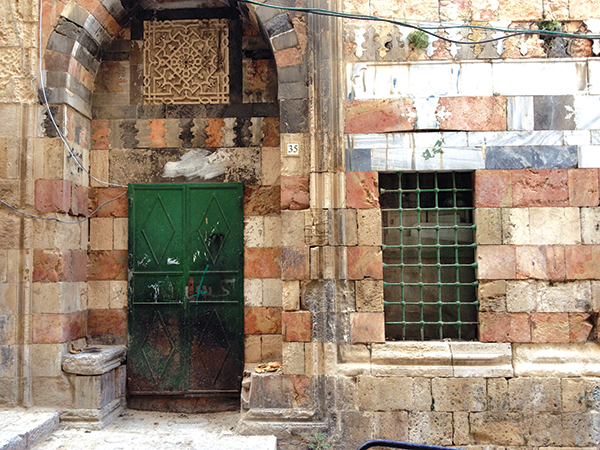
The ever-shifting, elusive “character” of Jerusalem is a reflection of the dynamic needs, desires, and wishes of its inhabitants. Intangible culture is not merely the listing of professions and trades; it is the sung parodies that advertise the new seasonal cucumber (asabe’ el bubbu ya khyar), and the variety of recipes that Jerusalamites swap about the best way to prepare artichokes and ‘akkube (a wild form of artichoke) or preserve bitter oranges both as marmalade and sharab, or even how to construct a kite using dough instead of glue, bamboo, and newspaper sheets. It also includes visiting the cemetery to pray for one’s deceased close relatives after the early morning ‘Eid prayers and reciting the fatihah each time one passes by a cemetery, mausoleum, or maqam. It is the marking of the Muslim New Year with green olive twigs on house doors, the special sweets, and the family visits. The homes we live in, the neighborhoods, the services rendered, the consumer lifestyle, the values and norms, and the way people interact is a world view in which tangible and intangible cultural expressions interweave to impart Jerusalem its unique character. It is the human art of making life livable.
The memory of the Afghani and Indian knife and scissor sharpeners huddled under their respective tents around the water fountain in Suq Aftimos brings to mind a city and trades that have vanished. They stooped over their grinding wheels that hissed and sparked flashes of fire that quickly turned to black cinder. Customers watched as their kitchen knives, scissors, and shaving-knife blades were sharpened.
♦ Intangible cultural heritage must be seen as a broader framework within which tangible heritage takes on its shape and significance. In Jerusalem, cultural tangible heritage operates in a synchronized relationship that involves systems of interactions that connect people, norms, and values, and that structures these intangible social operations. Thus the formal tangible heritage as expressed in architectural monuments, historical edifices, mosques, monasteries, public ovens, baths, public kitchens, and corresponding crafts and trades establishes a symbiotic relationship between the tangible and the intangible.
In every age, “the good old days” were a myth. In fact, every age has consisted of socio-economic political structural tensions and pressures that constitutively constitute the lived moment. Convenient solutions and the corollary actors who would perform these services were expediently improvised to ease the stress in response to ever-shifting human needs.
Porters (al-attalleen) milled around the entrance to al-bazaar; the crowded meat, vegetable, and fruit market. Al-attal, the porter, wore a distinctive headband and bore a wide and deep wicker basket. It would hang on the back – which would be protected by a straw-padded saddle – strapped to the torso and supported in place with a cord attached to the forehead. The rope would be padded with old carpet, burlap cloth, and other materials. Once a porter was contracted he would walk behind the customer who would load the basket with meat, chicken, okra, string beans, apples, and pears in huge amounts. Jerusalemite men went shopping once a week. It was thought unseemly for women to stoop down, bargain the price of tomatoes, pick the choice fruit, and lead the porter.
The image of the Jerusalem of the fifties and sixties is riveting. The hustle and bustle of al-suq was festive. Broom vendors jostled among brass shiners (مبيض النحاس), each advertising his trade. Sweeping the house floor was a daily chore, and a 30-centimeter brush with short, harsh bristles was essential for scrubbing the flagstone floor using finely grated Nablus soap dissolved in warm water.
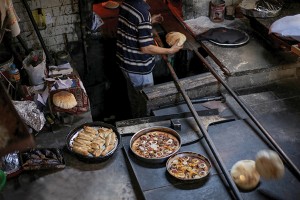
To recall my great grandmother’s cavernous kitchen brings warm recollections of family reunions in the old family house of Sitti Aisha, Im Abdel Ra’uf, in Bab al-Item, the northern gate of Al-Aqsa Mosque. The daily meals were cooked using a copper kerosene-fueled Primus. Once primed, it had to be pumped with a syringe-like piston on the side to keep it at full flame. It roared and made a lot of noise. Al-babbor was equally used to make Arabic coffee and tea, and to cook stews and mahashee (stuffed vegetables). It was a chore to light it, prime it, and keep the flame roaring. Once the cooking or the boiling of the water or coffee were over it would be turned off. The ensuing silence would be followed by a sigh of relief accompanied by the phrase: “There is no God but God.” (اشهد ان لا اله الا الله) The same epithet was used once children finally succumbed to deep sleep.
The burner of the Primus, through constant usage, would become blocked by accumulating soot. Primus repairmen abounded. “M’ammer bwabeer al-kaz…” was a call that announced that the itinerant repairman was in the neighborhood. More often than not the Primus would be left at one of the dingy, dark, dirty, specialized Primus repairmen’s shops.
Big cooking pots, special rice pots, colanders, frying pans of various shapes and sizes for family cooking and for the azayem (big family lunch reunions to celebrate various occasions) were piled on the kitchen shelves. All cooking utensils were of copper. This was before stainless steel and aluminum pots were introduced to Jerusalem. To avoid copper poisoning, the inside of the cookware would be polished and plated with a thin veneer of silvery zinc. It would be scrubbed off during cleaning, and the outside would turn black from the soot. In fact, the entire cavernous kitchen of Sitti Aisha was blackened by the soot.
The zinc veneer exacted a lot of care. The brass shiner favored by my family was a Lebanese man from Tripoli who belonged to the Sufi sect of the Melawiyeh. He set up shop alongside his fellow craftsmen in Khan al-Sultan. He would come with his donkey to our house to fetch the darkened pots and would return them silvery and shining…
Before the gas oven, Jerusalemites depended on the public oven (furon) for baking. Each quarter had its own furon. The eggplants and onions for eggplant salad (baba ghannuj) would be dispatched to al-furon. Al-lahmeh bi sinnieh, finely ground beef, would be baked either with tomatoes, zucchini, and potatoes or with tahini sauce, which the baker (farran) would add at the opportune moment. Food baked in the neighborhood oven had a special aroma and taste since olive wood was used in the baking. The master baker, an artisan chef, would be expert in the art of baking. Standing in the pit next to the Roman-like pizza oven (al-furon), he would expertly move the tray of meat alternately close, mid-range, and distant from the raging fire. Baking was an important ingredient in the art of Arabic cuisine that was entrusted to the farran who spiced and mixed the sauces for the various delicacies. The appetizing aromas saturated the neighborhood.
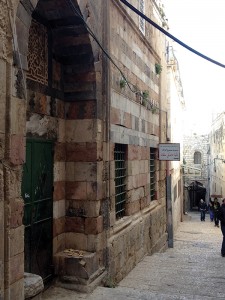
The lahmeh bi ajeen (meat pies), kaek u ma’mul (sweet pastries for both Christian and Muslim holidays), and the daily bread were baked to perfection in these ovens that have now fallen onto sad days for want of use. Mother would line the circular lahmeh bi ajeen pies in neat rows at home on the black baking trays dispatched early in the morning by ajeer al-farran, the baker’s errand boy. He would return later to carry them to al-furon. The dough for baking bread would be leavened and kneaded at home. It would be entrusted to al-farran to make the individual loaves. Al-farran was an undisputed artisan in his métier, hence the admonition against trying to divide the dough or bake at home. The proverbial phrase was conceived in this context: Give the bread to the baker even if he steals half of it.
(اعط الخبز للخباز ولو سرق نصه)
In the hustle and bustle of al-balad, the handsome gypsies – al-Nawar – stood out with their thick black mustaches as they carried their long, thin, pliable, iron plumbing pipes and went about their trade. Children and adults thronged around the various water faucets and sabyls (ornate Ottoman water fountains) in the various quarters to fetch water in tin tanks for domestic use. Whereas municipal water reached every house outside the walls, the service did not include al-balad, our word for downtown (the old city). Muscular, husky men specialized in carrying huge water containers and delivered them to each house.
Memory is interesting. Memory provides first-hand evidence of personal identity. I know that I am a Jerusalemite because I remember events and have my own recollections of being there. Memories allow one to know one’s own past, immediately and directly; they provide the tale that ties the present with the past and whose constituent elements articulate the collective narrative.
Though the architecture, major monuments, residential quarters, hosh (open courtyard shared by a few houses), labyrinthine alleys, and unique layout have barely changed over the past four centuries, the character of the city has undergone great changes. The post-Nakba Jerusalem of the fifties and sixties, my city is totally different from the Ottoman Jerusalem into which my father was born in the last decade of the nineteenth century. Similarly my daughter experiences yet another Jerusalem. The spirit of the place, that elusive intangible feeling of the place challenges travelers, anthropologists, and historians alike. Claude Levi-Strauss points out the apparent paradox in his succinct aphorism, namely, that anthropologists invariably arrive late. As delightful as the anecdotal accounts of China are in the travel books of Ibn Battuta and Marco Polo, the threads of which the fabric of everyday life is woven, those elusive intangible details that impart folk life its magic, are blatantly absent. Being a myopic witness is the anthropologist’s biggest fear.
The quest after authenticity is an ever-receding mirage. Yet the past is not privileged with a greater or lesser degree of authenticity. It is not necessarily a better moment or a worse moment than now. Jerusalem is a city of many veils and innumerable moments.
“Tazaah al-Timriyyeh, Sukneh al-Timriyeh,” the call of the itinerant street vendor advertising his fresh, sweetened-semolina fried stuffed pastry in the early afternoon still echoes in my ears. His image donned in a clean white apron has left an indelible memory.With one hand he would balance the wooden tray brimming with neatly packed sweet pastries on his head. The other hand would be tucking under his armpit a stool on which the tray would be laid as he sold his delicacies. Other vendors’ calls come to mind: “Balilah” (boiled chickpeas), “Turmus” (a local species of lentil), and brown cooked warm fava beans.
The echoes from the past leave an uneasy silence. Once Jerusalem’s change of season was indexed by the various calls. Early spring would be heralded with the calls of itinerant vendors: “Hamleh ya malan” (roasted chick peas on the stalks) and fresh green almonds…
Our awareness of time was punctuated by these calls. The concept of time is inherent in the concept of humanity. And in this awareness of time, we feel above all the weight of the past. When we remember, we recall events, experienced previously.
No trade, no craft, no performance, no cultural expression can be properly understood apart from the culture of which it is a part; nor should any “work” be looked on as a thing in itself apart from the continuum of creation-consumption.
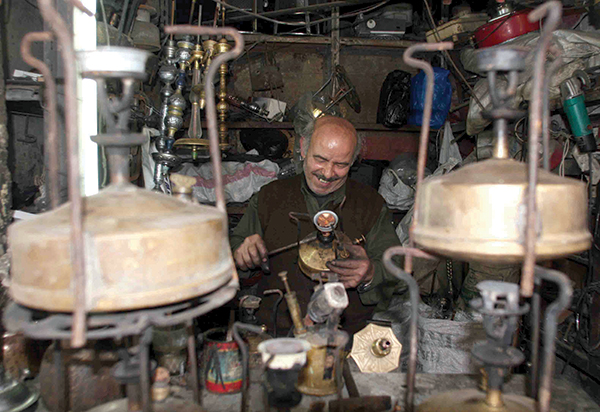
Intangible culture is often hidden in full view, lodged in the various ways we have of discovering and expressing who we are and how we fit into the world. It is reflected in the names we bear from birth, invoking affinities with saints, ancestors, or cultural heroes. Intangible culture is the secret language of children, the working slang of watermen and doctors, of blacksmiths, carpenters, and sheiks. It is the shaping of everyday experiences in stories swapped around kitchen tables or rumors circulating in cafés or topics discussed in Friday sermons.
On a Mamluk palace windowsill, intangible trade appears symptomatically in a crumb of hardened, weathered, abandoned bread on top of a heap of bread and ka’ek morsels. In fact, leftover bread crumbs are ubiquitous throughout Jerusalem. They fill every nook and cranny. One sees them at elevated doorsteps of homes, windowsills, and electricity or telephone cable metal boxes, sabyl basins. They hang in plastic bags on the side of the huge metal garbage containers. Here, there, and everywhere, leftover bread is deferentially placed in an elevated position. It is not unfamiliar to see a man or woman bend down to pick up a piece of bread, kiss it, and put it in a high place to avoid having it trampled over by inattentive pedestrians. Bread is sacred. It may lay exposed for extended hours to the sun, dust, and wind in the street. But it never turns dirty. It is pure; the grace of God and a blessing. In the same manner the old Qur’an books, once their binding disintegrates and the pages become loose, faded, and worn out, they are not tossed into the garbage but wrapped and put away deferentially. Similarly bread is never thrown inside the garbage bin. Rather it is neatly put aside, and at a later stage it is gathered inside bags to be collected by professional traders and sold to shepherds as fodder for sheep!
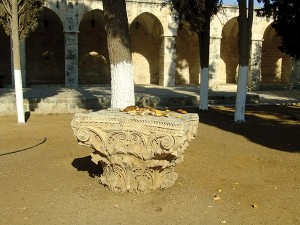
Intangible heritage is made up of processes and practices. It is fragile by its very nature and therefore much more vulnerable than other forms of heritage because it hinges on actors and social and environmental conditions which do not change too rapidly. While tangible cultural heritage is designed to survive long after the death of the person who produced or commissioned it, the fate of intangible heritage is much more closely related to the actors.
An all-encompassing approach to cultural heritage should prevail, which takes into account the dynamic link between the tangible and intangible heritage and their deep interdependence. Yet the underlying idea, forged 63 years ago in “Race and Culture,” Claude Levi Strauss’ seminal article, “is not to demonstrate that major groups that composed Humanity have brought, as such, specific contributions to our common heritage.” Instead, it is by ensuring greater and equal representation of all cultures through the reformulation of our heritage approach that we come closer to the idea of safeguarding the very fact of human diversity.
» Dr. Ali Qleibo is an anthropologist, author, and artist. A specialist in the social history of Jerusalem and Palestinian peasant culture, he is the author of Before the Mountains Disappear, Jerusalem in the Heart, and Surviving the Wall, an ethnographic chronicle of contemporary Palestinians and their roots in ancient Semitic civilizations. Dr. Qleibo lectures at Al-Quds University.
This article was inspired by conversations with my friends in the UNESCO office in Ramallah, in particular, Dr. Lodovico Folin-Calabi, Head of Office, a.i., and Mr. Junaid Sorosh-Wali, Culture Programme Specialist.


